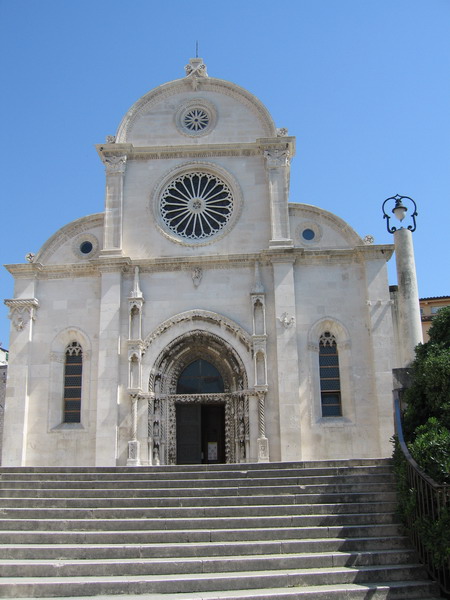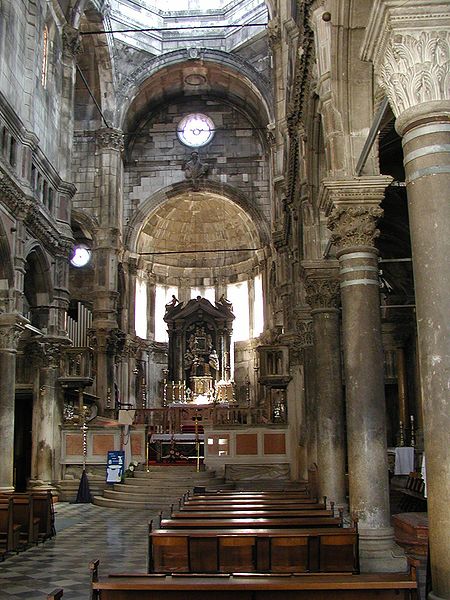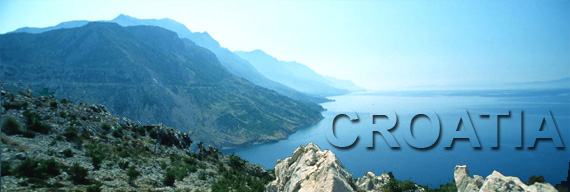| |
Sibenik Cathedral
|
 |
The Cathedral of St. James in Sibenik,
Croatia (Katedrala sv. Jakova) is
unique in Europe, built exclusively from stone using the skeletal
construction
technique which joins large slabs in a mortice and pener manner.
This building, originally
designed by master Juraj Dalmatinac in 1441, was finished in the early
16th Century
by Nikola Firentinac (Niccolò Fiorentino).

The Sibenik Cathedral is dedicated to Saint James the Greater and has
been on the UNESCO World Heritage List since 2000. |
 |
 DID YOU KNOW? DID YOU KNOW? |
The
Sibenik Cathedral is dedicated to Saint James the Greater, but it is
often mistakenly known as "St Jacob's", because Croatian, like many
other languages, uses the same name for both "James" and "Jacob".
The building of the Sibenik Cathedral was initiated in 1402, though
plans on
its construction had already begun in 1298, when Sibenik became a
municipality.
The actual work to transform the older church began in
1431. A multitude of Venetian and local craftsmen worked on it, in
Gothic style.
In 1441, the Grand City Council entrusted the work to the master
Giorgio da Sebenico (Giorgio Orsini or Juraj Dalmatinac). He enlarged
the cathedral with a side nave and apses, prepared it for the dome and
added various sculptural decorations, including 71 small human heads on
the outer sides and a baptistery, all in stone. Juraj Dalmatinac worked
on the Sibenik Cathedral up to his death in 1475.
Between 1475 and 1505 the work on the Sibenik Cathedral was overseen by
Tuscan master Nikola Firentinac (Niccolò Fiorentino). He
continued the building in the Renaissance style, completing the dome,
the outer sculptures of St. Michael, St. James and St. Mark, the roof
and the upper façade.
He also built the triforias (parallel galleries) and worked on the
presbytery and sanctuary.
After Fiorentino died in 1505, the
construction was finally completed in 1536 by two other craftsmen,
Bartolmeo of Mestra and his son Jacob, completely following Nicholas'
instructions.
The cathedral officially became consecrated
in 1555.
The dome of the church was heavily damaged
by the JNA-supported
Serb forces during the shelling of Sibenik in September 1991. Within
years it was quickly repaired with no damage visible.

|
 |
 RELATED LINKS RELATED LINKS |
 Discover
Beautiful
Croatia - Visit
Croatia and you will never forget the unforgettable natural beauty of
the
place where the Mediterranean, the Alps and the Pannonian plain come
together. Discover
Beautiful
Croatia - Visit
Croatia and you will never forget the unforgettable natural beauty of
the
place where the Mediterranean, the Alps and the Pannonian plain come
together.
 Croatian
National Parks - Of the eight national parks,
four are in the mountain regions (Risnjak, Paklenica, Velebit and the
Plitvice Lakes) and four are in the coastal area (Kornati, Mljet,
Brijuni and Krka). Croatian
National Parks - Of the eight national parks,
four are in the mountain regions (Risnjak, Paklenica, Velebit and the
Plitvice Lakes) and four are in the coastal area (Kornati, Mljet,
Brijuni and Krka).
 Croatian
Nature Parks & Strict Reserves - Croatia can pride itself on
its unpolluted
environment
and abundant plant and animal life outside the areas under protection. Croatian
Nature Parks & Strict Reserves - Croatia can pride itself on
its unpolluted
environment
and abundant plant and animal life outside the areas under protection.
 Croatian
City Guide - The other dimension of Croatia is the urban culture:
towns are more numerous here than in any other part of Southeastern
Europe. Croatian
City Guide - The other dimension of Croatia is the urban culture:
towns are more numerous here than in any other part of Southeastern
Europe.
 Croatian
Accommodations Info - Croatia offers great accommodations for
business and pleasure. After all, tourism
in the modern sense began in Croatia in the 19th century. Croatian
Accommodations Info - Croatia offers great accommodations for
business and pleasure. After all, tourism
in the modern sense began in Croatia in the 19th century.
 Visit
Zagreb - Croatian gorgeous capital city has been a focal point of
culture and science, and now this charming
city
is the hub of the business, academic, cultural, artistic and sporting
worlds
in Croatia. Visit
Zagreb - Croatian gorgeous capital city has been a focal point of
culture and science, and now this charming
city
is the hub of the business, academic, cultural, artistic and sporting
worlds
in Croatia.
 Croatian
Islands - Croatia has an impressive
number of over 1000 islands, reefs and cliffs. A vast majority of the
Adriatic sea islands are located near the northeastern,
Croatian coast. Croatian
Islands - Croatia has an impressive
number of over 1000 islands, reefs and cliffs. A vast majority of the
Adriatic sea islands are located near the northeastern,
Croatian coast.
 Croatia
- Photo Gallery - Click
here to see images and virtual tours of Croatia. Croatia
- Photo Gallery - Click
here to see images and virtual tours of Croatia. |
 |
|
|
|
|













